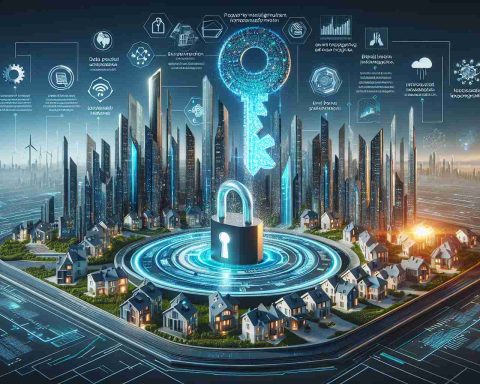## Revolutionary Error Correction in Quantum Computing
A remarkable advancement in quantum computing has been achieved by a team of physicists, who have developed a dynamic error-correction strategy that allows quantum computers to seamlessly switch between multiple error correction codes. This innovative approach is pivotal for enhancing the accuracy of complex computations.
Traditionally, classical computers utilize various methods to detect and correct errors, often by comparing multiple copies of data. However, quantum computers encounter a significant obstacle: the impossibility of copying quantum states. To address this issue, researchers have utilized concepts from classical error correction to create redundancy within quantum systems, distributing information across several entangled qubits for error detection and correction.
In a pioneering study, researchers led by Thomas Monz from the University of Innsbruck successfully executed a universal set of operations on fault-tolerant quantum bits, demonstrating a new way to design quantum algorithms that effectively correct errors during computations. A significant challenge, however, remains: no single correction code can meet all operational needs efficiently in a fully programmable quantum system.
To tackle this, the team led by Markus Müller has introduced a method that enables the quantum computer to alternate between two different error correction codes. This flexibility allows for easier execution of complex logic gates and enhances computational accuracy. The groundbreaking findings have been documented in the esteemed journal, Nature Physics, reflecting years of collaboration between the research teams involved.
Financial backing for this research came from multiple esteemed institutions, highlighting the significance of their work in the field.
The Transformative Potential of Enhanced Quantum Error Correction
The recent breakthroughs in quantum computing error correction herald profound implications for society and the global economy. As quantum technologies evolve, their ability to solve problems beyond the reach of classical computing could reshape industries. From pharmaceuticals developing novel drugs to optimization problems in logistics, the accuracy provided by dynamic error correction can dramatically enhance efficiency and innovation across sectors.
Moreover, the long-term significance of such advancements extends into environmental sustainability. Quantum computing can facilitate new materials science research, leading to breakthroughs in energy storage and renewable energy technologies. The transition towards greener, more efficient technologies is a critical global agenda, and robust quantum systems could expedite research processes that reduce carbon footprints.
Future trends suggest that as quantum computing matures, its integration into our daily lives will intensify. Financial markets, healthcare, and artificial intelligence could leverage enhanced computational capabilities to create disruptive innovations. As organizations adapt to this paradigm shift, substantial investment in these technologies is likely, drawing significant attention from venture capital and governments alike.
In essence, the evolution of error correction in quantum computing represents a pivotal leap not just in computational power but in how we address complex global challenges, paving the way for a technology-driven future with far-reaching societal impacts.
Unlocking Quantum Potential: A Game Changer in Error Correction
## Revolutionary Error Correction in Quantum Computing
Recent advancements in quantum computing have unveiled a dynamic error-correction strategy that significantly enhances the accuracy and reliability of quantum computations. Developed by a collaborative team of physicists, this innovative method allows quantum computers to switch seamlessly between multiple error correction codes, offering promising implications for the future of quantum technology.
How the Dynamic Error-Correction Strategy Works
Quantum computers face unique challenges in error correction due to the complex nature of quantum states. Unlike classical computers, which can manage errors by comparing multiple data copies, quantum systems cannot replicate quantum states due to the no-cloning theorem. Instead, researchers have implemented redundancy within quantum systems by distributing information across several entangled qubits. This advanced strategy ensures that information remains intact, even in the presence of errors.
Key Players in Quantum Research
The study led by Thomas Monz from the University of Innsbruck demonstrated a universal set of operations on fault-tolerant quantum bits. By integrating new approaches to quantum algorithms, they showcased an effective method for correcting errors in real-time during computations.
However, the research team, spearheaded by Markus Müller, proposed a solution to a critical challenge: the need for flexibility in using multiple error correction codes. By alternating between two different codes, quantum systems can more efficiently handle complex logic gates, thereby enhancing overall computational accuracy. This finding was published in the reputable journal Nature Physics and highlights years of joint efforts from various research entities.
Pros and Cons of the New Method
# Pros:
– Enhanced Accuracy: Improved error detection and correction lead to more reliable quantum computations.
– Flexibility: The ability to switch between error correction codes allows for a broader range of applications within quantum algorithms.
– Scalability: As quantum systems grow, this method could facilitate more sophisticated computations without significant loss of fidelity.
# Cons:
– Complex Implementation: Transitioning to this new paradigm may require significant updates to existing quantum architectures.
– Resource Intensive: Dynamic error correction may demand additional qubits and resources, posing challenges for scalability.
Use Cases of Dynamic Error Correction
1. Quantum Cryptography: Enhancing error correction could lead to more secure quantum communication systems.
2. Quantum Simulations: Researchers can simulate complex quantum systems with greater fidelity, providing insights into quantum phenomenology.
3. Advanced Machine Learning: Quantum algorithms could benefit from reduced error rates, allowing for more complex data processing tasks.
Future Implications and Innovations
As quantum computing continues to evolve, this dynamic error-correction technique holds the potential to overcome some of the significant barriers that have hindered its widespread adoption. Ongoing research may lead to even more innovative solutions, propelling advancements in various sectors, including pharmaceuticals, materials science, and artificial intelligence.
Market Analysis and Trends
Investing in quantum computing technologies is witnessing a surge, as both public and private sectors recognize the transformative potential of this field. With ongoing funding from esteemed institutions, the momentum behind quantum research is expected to grow, ultimately fostering an environment ripe for innovation and discovery.
Conclusion
The recent breakthroughs in quantum error correction signify a pivotal moment in the evolution of quantum computing. By merging classical concepts with cutting-edge quantum strategies, researchers are poised to advance the capabilities and applications of quantum technologies dramatically. The future of quantum computing is bright, bolstered by strategies that enhance reliability and performance.
For more on the latest in quantum computing, visit Nature.













